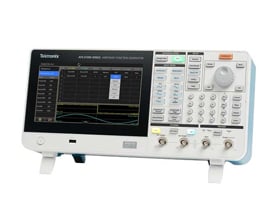Contact us
Call us at 1-800-833-9200
Available 6:00 AM – 5:00 PM (PST) Business Days
Download
Download Manuals, Datasheets, Software and more:
Feedback
What is a signal generator?
Tektronix signal generators cover a wide range of applications from replicating sensor signals to creating high-speed serial data or RF signals with digital modulation applied. Each versatile signal generator can create a virtually unlimited number of signals—analog or digital, ideal or distorted, standard or custom. From the world's only direct synthesis of high-speed serial data waveforms for simplified receiver testing to the world's most versatile arbitrary function generator for common stimulus signals to flexible RF signal generators for analog and digital applications, Tektronix has a signal generator to meet any debugging challenge.

Types of Signal Generators
Compare Specifications for RF Signal Generators, Function Generators and Arbitrary Waveform Generators
| Model | Channels | Vertical resolution | Bandwidth | Frequency | Sample rate | Record length | List Price | |
|---|---|---|---|---|---|---|---|---|
 |
AFG31000 series arbitrary function generator | 1-2 | 14 bits | 25 MHz to 250 MHz | 25 MHz to 250 MHz | 250 MS/s - 2 GS/s | 16 MSa/ch | US $2,930 Configure & Quote |
| AFG1022 arbitrary function generator |
2 | 14 bits | 25 MHz | 1 uHz to 25 MHz | 125 MS/s | 8k points | US $1,180 Configure & Quote |
|
| AFG1062 arbitrary function generator |
2 | 14 bits | 60 MHz | 1 uHz to 60 MHz | 300 MS/s | 1M points | US $1,620 Configure & Quote |
|
| AFG2000 arbitrary function generator | 1 | 14 bits | 20 MHz | 20 MHz | 250 MS/s | 128k points | US $2,710 Configure & Quote |
|
 |
||||||||
| AWG5202 arbitrary waveform generator |
2 | 16 bits | 2 GHz (at -3 dB x) | Direct DC Out: 1.5Vp-p Diff Direct AC Out: -17 to -5 dBm single-ended, BW 10MHz to 2GHz (standard) Amp AC Out: -85 to +10 dBm single-ended, BW 10MHz to 2GHz (option) |
1.5 KS/s – 10 GS/s (4 GHz) | - | Configure & Quote |
|
| AWG5204 arbitrary waveform generator |
4 | 16 bits | 2 GHz (at -3 dB x) | Direct DC Out: 1.5Vp-p Diff Direct AC Out: -17 to -5 dBm single-ended, BW 10MHz to 2GHz (standard) Amp AC Out: -85 to +10 dBm single-ended, BW 10MHz to 2GHz (option) |
- | - | Configure & Quote |
|
| AWG5208 arbitrary waveform generator |
8 | 16 bits | 2 GHz (at -3 dB x) | Direct DC Out: 1.5Vp-p Diff Direct AC Out: -17 to -5 dBm single-ended, BW 10MHz to 2GHz (standard) Amp AC Out: -85 to +10 dBm single-ended, BW 10MHz to 2GHz (option) |
- | - | Configure & Quote |
|
| AWG70002B arbitrary waveform generator |
2 | 8, 9, or 10 bits | Up to 13.5 GHz | 10 GHz | 25 GS/s | 2 GS, 16 GS (Optional) | Configure & Quote |
|
| AWG70001B arbitrary waveform generator |
1 | 8, 9, or 10 bits | Up to 15 GHz | 20 GHz | 50 GS/s | 2 GS, 32 GS (Optional) | Configure & Quote |
Signal generator FAQs
What is a signal generator used for?
A signal generator is an analog or digital device that engineers use to create electronic signals and send them to a device under test (DUT) when testing circuit designs. There are a number of different types of signal generators, including RF signal generators, function generators, arbitrary waveform generators, and vector signal generators.
How does a signal generator work?
A signal generator creates voltage waveforms at a desired frequency and applies them to a device under test (DUT). Using the instrument’s front panel, the operator can easily set and adjust the most important parameters of a waveform, such as how fast it’s played, the amplitude and offset, or add basic distortion or modulation.
What’s the difference between signal generators and function generators?
A signal generator is any device that creates electronic signals. A vector signal generator specializes in creating RF signals with analog and digital modulation schemes in formats such as QAM, QPSK, FSK, BPSK, and OFDM. Vector signal generators are commonly used for receiver sensitivity testing.
A function generator generally has a preset list of waveforms or patterns that it can play. The operator can change the parameters of a waveform, such as how fast it’s played, the amplitude and offset, or add basic distortion or modulation.
What are the types of signal generators?
There are many types of signal generators. View the chart below to see the differences between each.
| Signal Generator | Generic category name for analog and digital electronic signal sources. |
| Function Generator | Signal generators are typically used when common waveforms like sine, wave, triangular, etc. are needed. |
| Arbitrary Function Generator | Function generators are capable of arbitrary compiled waveforms. |
| Arbitrary Waveform Generator | Arbitrary waveform generators are mostly used when custom compiled waveforms (rather than preset common waveforms) are needed. |
| RF Signal Generator | RF signal generators are used for wireless applications and typically provide normal analog modulation such as AM, FM, and PM as well. |
| (RF) Vector Signal Generator | RF vector signal generators support both analog and vector modulation on RF carriers for digital communication applications. |





